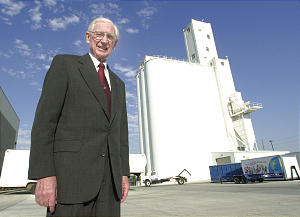Mormon Money
Some people are impressed by the "wealth" of The Church of Jesus Christ of Latter-day Saints, the Mormon Church, which in late 2009 had nearly 14,000,000 members. This means that there are about as many Mormons in the world as there are Jews. The LDS Church is a small church, compared to traditional Christianity or Islam, which each count for nearly 1 billion people each.
Faithful Mormons pay 10% of their "increase" as tithes to the Church. This money is used to finance the building of meetinghouses, temples, and for the general management of the Church. Latter-day Saints also contribute monetarily in other ways. It is traditional to fast for two meals on the first Sunday of each month, and then to contribute the monetary value of the meals to the Church for the welfare of the poor. The Church has its own exemplary welfare system, with farms and ranches, processing of food by volunteers and missionaries, and "Bishop's Storehouses", which are like mini-supermarkets, providing food for the poor who have a requisition slip from their bishops. Non-food items are also available from bishop's storehouses and from Deseret Industries thrift stores run by the Church.
Mormons also have the option to commit extra funds to Humanitarian Aid, missionary funds, the Perpetual Education Fund, temple construction funds, and others. The Church has a few commercial projects, too, but the central reason for the Church's prosperity lies in four things: 1) the generousity of the Latter-day Saints; 2) good management of the Lord's funds and resources; 3) a lay clergy -- all but the highest level servants in the Church fill temporary callings with no remuneration; and 4) the Lord's hand in prospering His Church.
Time Magazine, in its August 4, 1997, issue, showed the Salt Lake Temple on its cover, with the bold headline, Mormons, Inc: The Secrets of America's Most Prosperous Religion. The article called the Mormon welfare system, "perhaps the largest nonpublic venture of its kind in the country." Time Magazine's 1997 article posted church assets at a minimum of $30 billion, then praised the probity of Mormon management (the Church never goes into debt to build a temple; it pays cash). The article described the "top beef ranch in the world," the Deseret Cattle and Citrus Ranch outside of Orlando, Florida, USA, which covers 312,000 acres; Agreserves, Inc., which produces nuts; Bonneville International radio chain; and the Beneficial Life Insurance Company. The article then admitted that Roman Catholic holdings dwarf those of the Mormon Church, but that is with 45 times more members. "There is no major church in the U.S. as active as the Latter-day Saints in economic life, nor, per capita, as successful at it." In 1996 $5.2 billion in tithes were collected by the Church, $4.9 billion of it from American Mormons. The Church invests in its own for-profit ventures, and does so in order to be self-sufficient. With a past (and increasingly, present) experience with ostracism and bigotry, and with biblical prophecies of hard times to come, the Church expects to physically support its members in the future, though it encourages members to be as self-sufficient as possible.
Domestic and for-profit investments have slowed since 1997. The Church has divested itself of some commercial interests.
- Employment resource service centers provide a place where people can receive job training, learn to enhance their résumé and find job opportunities. There are 259 centers around the world.
- There are 129 bishops’ storehouses located around the world.
- The Church has over 80,000 (2013) full-time missionaries serving at any given time. Although the Church pays for travel to and from the mission, missionaries are otherwise self-supporting.
- In 2013, there were 141 functioning temples, with others being built.
- In 2013, there were over 29,000 Mormon congregations.
- $884.6 million in humanitarian aid has been given since 1985. (As of 2009.)
*See also LDS Church Finances
